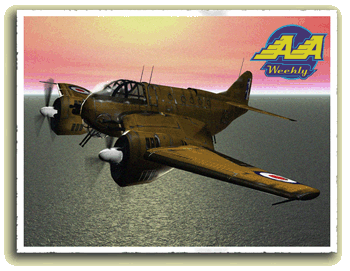
 |
|
||||||||||||||||
 |

Aircraft In Review  Featured Aircraft: The Type 140 Balmoral
Featured Aircraft: The Type 140 BalmoralBy Lance "Lightning" Hawkins Sometimes, as a reporter for Air Action Weekly, I get a chance to fly a plane I wouldn't expect to see the inside of. Last month, while visiting Ontario I had the opportunity to fly an older British light bomber, the Type 140 Balmoral—one of the post-War mainstays of the British Royal Air Force. The Balmorral has seen service around the world in the service of the British Empire and is now the backbone of British colonial bomber support in Africa, Asia, and the Pacific. The Plane Balmorals can be found all over the globe in Dominion air forces. Properly used as a hammering bomber, it serves for pinpoint bombing of nearly any target; it has terrible range, however, and is usually used against known, pre-scouted targets. The Balmoral mounts an astonishing ten rocket hardpoints, two .30-caliber turrets, one forward and one rear, and four pilot-fired .50-caliber machine guns, which are often upgraded to .60- or even .70-caliber guns in the field. The Balmoral is also heavily armored and reinforced; this kind of firepower draws a lot of enemy attention, and the Balmoral is widely known to evade like an overfed bull. The Test My co-pilot was Captain Wesley Dawes, an RACF squadron commander. My test was to destroy a series of ground targets on Fitzwilliam Island, followed immediately by a series of blimp targets off the island shore. Evaluation My run required me to make a series of close-in pinpoint rocket attacks with high explosive rockets. I was a little hesitant to take the Balmoral down too close to the terrain until Captain Dawes urged me to "clip the tree-tops." I managed a decent 34% for direct hits, with a 68% for destroyed targets. The Balmoral isn't exceptionally accurate compared to a fighter-bomber, but is quite good for a light bomber and packs enough of a payload to hammer targets with a double dose of rocket fire. The wing-mounted cannon didn't do much for accuracy, but did allow me to strafe the area, and the four .50s deliver a respectable punch to sand-bagged guns and targets. An interesting tactic that slipped out was the habit of the tail gunner to fire a burst on whatever target I just bombed, probably a follow-through tactic to make sure the surviving gunners don't snap a shot at my tail. Overall, the combination of toughness reliability and firepower makes the Balmoral a sturdy classic. Hardly surprising the Balmoral is still in service across the Empire.
|